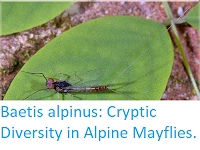Mayflies, Ephemeroptera, are an ancient group of insects related to the Dragonflies and
Damselflies. They have a long aquatic larval stage followed by a short
flying adult phase, which typically does not feed, simply emerging from
the water, mating, and laying eggs at a new site. This adult form,
called the imago may survive from a few hour to a few days, depending on
the species. Spiny Crawler Mayflies, Ephemerellidae, are a distinctive group of Mayflies found in North America and the UK. They have three tails (as opposed to two in most Mayflies), and the larvae have the habit of raising these up in a Scorpion-like posture when disturbed. These larvae are found in a wide variety of aquatic environments, and can often survive out of the water for some time.
In a paper published in the journal ZooKeys on 6 November 2017, Wei Zhang, Zhen-Xing Ma, Ze Hu, Juan-Yan Luo, and Chang-Fa Zhou, all of the Key Laboratory of Jiangsu Biodiversity and Biotechnology at Nanjing Normal University, describe a new species of Spiny Crawler Mayfly from Hainan Island in China.
The new species is placed in the genus Teloganopsis, which currently contains only a single species, from the eastern United States, and given the specific name setosa, meaning 'hairy'. It is describe from a number of both adult and larval specimens gathered in the Ba-Wang-Ling National Forest Park, in Chang-Jiang County, Hainan; the larvae were collected by hand-netting, while the adults were attracted with an ultra-violet lamp. Some of the larvae were subsequently raised in captivity, confirming they were the same species.
Teloganopsis setosa, male adult. Zhang et al. (2017).
Adults of Teloganopsis setosa measure 5.0-6.0 mm (males) or 6.5-7.0 mm (females). Adults of both sexes are pale in colour, the males have red markings on their eyes and wings, in the females these are smaller and a dull brown colour. The larvae are a dark, reddish brown.
Male nymph of Teloganopsis setosa. Zhang et al. (2017).
See also...
Follow Sciency Thoughts on Facebook.






